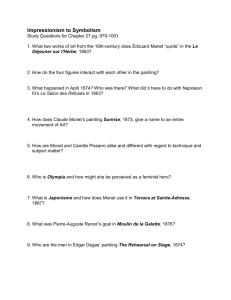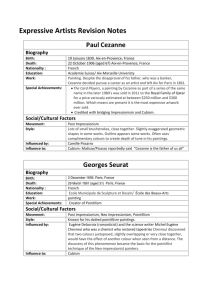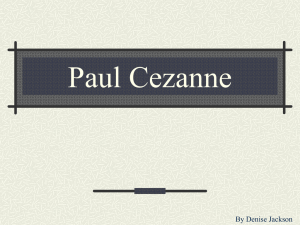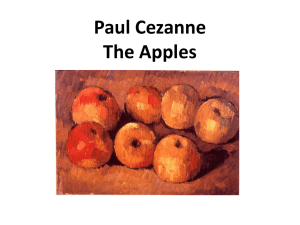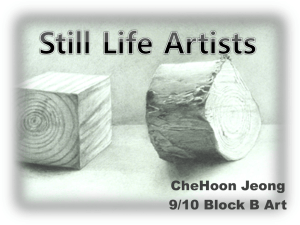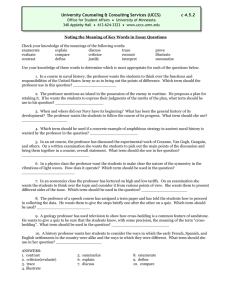Masterpiece: “The Basket of Apples” Artist: Paul Cezanne (Pol Say
advertisement
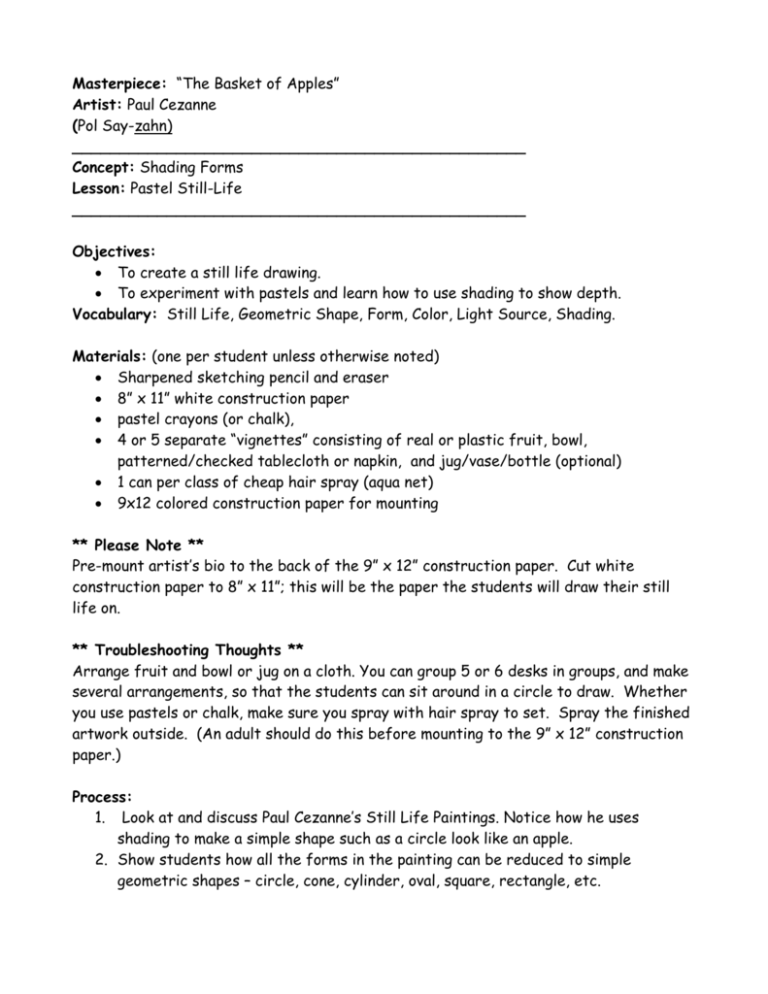
Masterpiece: “The Basket of Apples” Artist: Paul Cezanne (Pol Say-zahn) ________________________________________________ Concept: Shading Forms Lesson: Pastel Still-Life ________________________________________________ Objectives: • To create a still life drawing. • To experiment with pastels and learn how to use shading to show depth. Vocabulary: Still Life, Geometric Shape, Form, Color, Light Source, Shading. Materials: (one per student unless otherwise noted) • Sharpened sketching pencil and eraser • 8” x 11” white construction paper • pastel crayons (or chalk), • 4 or 5 separate “vignettes” consisting of real or plastic fruit, bowl, patterned/checked tablecloth or napkin, and jug/vase/bottle (optional) • 1 can per class of cheap hair spray (aqua net) • 9x12 colored construction paper for mounting ** Please Note ** Pre-mount artist’s bio to the back of the 9” x 12” construction paper. Cut white construction paper to 8” x 11”; this will be the paper the students will draw their still life on. ** Troubleshooting Thoughts ** Arrange fruit and bowl or jug on a cloth. You can group 5 or 6 desks in groups, and make several arrangements, so that the students can sit around in a circle to draw. Whether you use pastels or chalk, make sure you spray with hair spray to set. Spray the finished artwork outside. (An adult should do this before mounting to the 9” x 12” construction paper.) Process: 1. Look at and discuss Paul Cezanne’s Still Life Paintings. Notice how he uses shading to make a simple shape such as a circle look like an apple. 2. Show students how all the forms in the painting can be reduced to simple geometric shapes – circle, cone, cylinder, oval, square, rectangle, etc. 3. Also discuss where the light source in the painting is. When the source of the light is known, it will be much easier to see how the shading is done. 4. Hand out 8” x 11” white construction paper and pastels. 5. Have the students sketch the fruit, using geometric shapes. Then have them color in their shapes with pastels. 6. Color and shading is an important step. First determine where the light is falling on the fruit. Then add white or yellow in an arc or banana-shape near the upper edge of the fruit. Then at the opposite edge of the fruit, they can add a dark color in a banana-shape to show a shadow. Brown, blue, purple or even dark green can be used as a shadow color. They can blend their colors in the picture by using their fingers. This will create the illusion of light and shadow on their fruit and objects. 7. When they are done shading and blending, they may outline the fruit with black pastel. When the project is done, have an adult volunteer go outside and spray to set the artwork. Mount the dry art on a larger piece of colored construction paper. Then the project will be rea 5th GRADE--PROJECT #3 Artist: Paul Cezanne Masterpiece: The Basket of Apples Lesson: Pastel Still-Life/Shading Forms Project Samples: Art Masterpiece Paul Cezanne (1 8 3 9 – 1 9 0 6 ) This month we looked at the work of the French painter Paul Cezanne. His work was influenced by the Impressionist painters of the time but his style of painting came from the use of blocks of color to give form to shapes. He was an outcast from traditional painting while he lived. Cezanne worked very slowly; the fruit in his still-lifes often rotted before he had finished painting! (For this reason he didn’t paint very many portraits). His work slowly evolved from Impressionism toward Modern, Abstract art. Pablo Picasso, a modern abstract artist, referred to him as the “father of us all”. Today we made a still-life in colorful pastel, using shapes and shading in the style of Paul Cezanne. Art Masterpiece Paul Cezanne (1 8 3 9 – 1 9 0 6 ) This month we looked at the work of the French painter Paul Cezanne. His work was influenced by the Impressionist painters of the time but his style of painting came from the use of blocks of color to give form to shapes. He was an outcast from traditional painting while he lived. Cezanne worked very slowly; the fruit in his still-lifes often rotted before he had finished painting! (For this reason he didn’t paint very many portraits). His work slowly evolved from Impressionism toward Modern, Abstract art. Pablo Picasso, a modern abstract artist, referred to him as the “father of us all”. Today we made a still-life in colorful pastel, using shapes and shading in the style of Paul Cezanne. Art Masterpiece Paul Cezanne (1 8 3 9 – 1 9 0 6 ) This month we looked at the work of the French painter Paul Cezanne. His work was influenced by the Impressionist painters of the time but his style of painting came from the use of blocks of color to give form to shapes. He was an outcast from traditional painting while he lived. Cezanne worked very slowly; the fruit in his still-lifes often rotted before he had finished painting! (For this reason he didn’t paint very many portraits). His work slowly evolved from Impressionism toward Modern, Abstract art. Pablo Picasso, a modern abstract artist, referred to him as the “father of us all”. Today we made a still-life in colorful pastel, using shapes and shading in the style of Paul Cezanne. Paul Cezanne (1839 – 1906) Paul Cezanne was born in 1839 in Aix-en-Provence, near the Mediterranean coast in France. He was the son of a hat dealer who became a very prosperous banker. Cezanne first studied law but abandoned it in favor of art. Cezanne was close friends with a man who later became a well known author. They decided to move to Paris to further their art. They moved to Paris in 1863. Cezanne became acquainted with the Impressionists. He knew Manet and Pissaro and he exhibited with them in the first Impressionist show. Cezanne was largely self-taught. His paintings seemed to draw more criticism than the others because of the harsh colors he used, and his rough paint surface. He did much of his art work with a palette knife. He exhibited with the Impressionists one more time, but never really totally identified with the group. Cezanne was a different kind of man. He once refused to shake hands with Manet because he claimed that he, Cezanne, had not washed for days and did not want to dirty such a great man as Manet. He married a woman named Hortense Fiquet, and they had a son named Paul. Cezanne’s father died in 1886 and left him a great deal of money and the family home. He and his family moved to Aix. Cezanne lived there most of the rest of his life. He devoted himself principally to certain favorite themes, portraits of his wife, still lifes, and landscapes of Provence. He was an extremely slow painter. He is said to have had over 100 sitting for one portrait before he decided not to finish it. It was only after the age of fifty that Cezanne won praise for his work. In 1906 he wrote: “I am old and ill and have sworn to myself to die painting.” In October of 1906 he collapsed after being caught in a storm while painting outdoors, and died a few days later at the age of 67. While Cezanne was alive his art dealer divided his paintings into two sizes. He sold them for $64.00 for the large ones and $26.00 for the small ones. In 1964 a Cezanne painting sold for 1.4 million. Cezanne is considered the father of modern art, and had a profound effect on Picasso.


